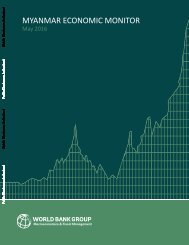Myanmar
1WZPRL1Jj
1WZPRL1Jj
- No tags were found...
Create successful ePaper yourself
Turn your PDF publications into a flip-book with our unique Google optimized e-Paper software.
CHAPTER 3. Data analysis<br />
this effect does not appear to be very large – a 1<br />
per cent increase in the number of employees is<br />
estimated to reduce productivity by only 0.22 per<br />
cent. The apparent higher productivity of micro firms<br />
appears to have more to do with their small workforce<br />
rather than their superior revenue earning capacity.<br />
More than 40 per cent of micro firms (1-9 employees)<br />
earn less than 100 lakhs ($10 000) per year, while 50<br />
per cent of large firms (250+ employees) earn more<br />
than 10 000 lakhs ($1 million) per year (figure 3.56).<br />
The lower labour productivity of larger firms may be<br />
related to financing constraints that restrict capital<br />
expenditure on machinery and equipment that<br />
complement labour in the production process. In<br />
other words, given the relative scarcity of capital in<br />
<strong>Myanmar</strong>, larger firms achieve lower labour productivity<br />
than smaller firms – possibly because larger firms<br />
are over-utilizing their fixed stock of capital. Another<br />
possible theory is that some of larger enterprises,<br />
which comprise various firms with different types of<br />
ownership – such as domestic enterprises, stateowned<br />
enterprises (SOEs), state-controlled enterprises<br />
and military enterprises as well as joint ventures and<br />
foreign companies – may aim to maintain or create<br />
employment beyond the profit maximizing level for<br />
political reasons through political interventions instead<br />
of seeking revenue or profit maximization. This issue<br />
is further investigated below.<br />
3. Higher revenue does not necessarily mean higher<br />
profits<br />
The respondents reported that, on average, almost<br />
20 per cent of sales revenue was retained as profit.<br />
This high profit margin may be due to low levels<br />
of competition in the heavily regulated markets or<br />
because respondents may misunderstand their cost<br />
structure when reporting this figure.<br />
There also appear to be important differences across<br />
sectors. Although firms in manufacturing and agriculture<br />
earn the highest revenue (figure 3.57), their reported<br />
profit margin (figure 3.58) is less than the average of<br />
the sample as a whole. Hotels and restaurants earn<br />
less revenue, on average, but they have the highest<br />
profit margin at almost 30 per cent. Firms in extractive<br />
industries earn the least revenue, on average, as well<br />
as the lowest profit margin at just 10 per cent. These<br />
results are contrary to the common understanding that<br />
the extractive and manufacturing sectors generally have<br />
a higher profit structure than other industries (cf. Abe<br />
and others, 2012). This requires further investigation<br />
by the Government in order to determine whether<br />
the lower profits are a result of corruption or other<br />
structural factors.<br />
Figure 3.56. Annual revenue, by size of firm<br />
Micro<br />
Small<br />
Medium<br />
Large<br />
0 20 40 60 80 100<br />
Percentage of respondents<br />
Less than 50 lakhs<br />
50-100 lakhs<br />
101-500 lakhs 501-1 000 lakhs<br />
1 001-5 000 lakhs 5 001-10 000 lakhs<br />
10 001-50 000 lakhs 50 001-100 000 lakhs<br />
100 001-500 000 lakhs More than 500 000 lakhs<br />
Source: ESCAP-OECD-UMFCCI <strong>Myanmar</strong> Business Survey Database.<br />
53







